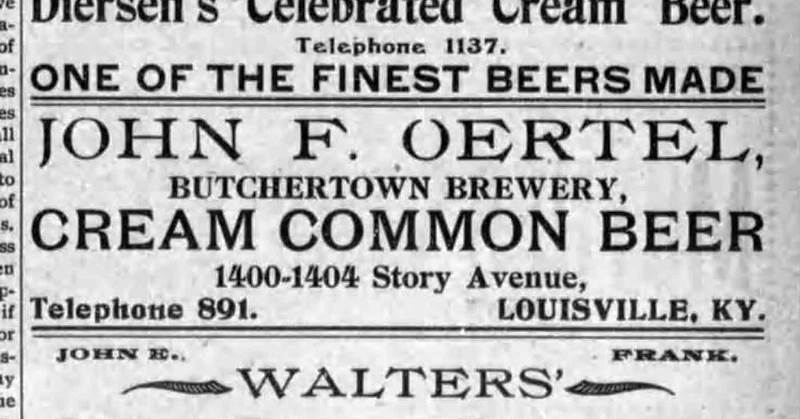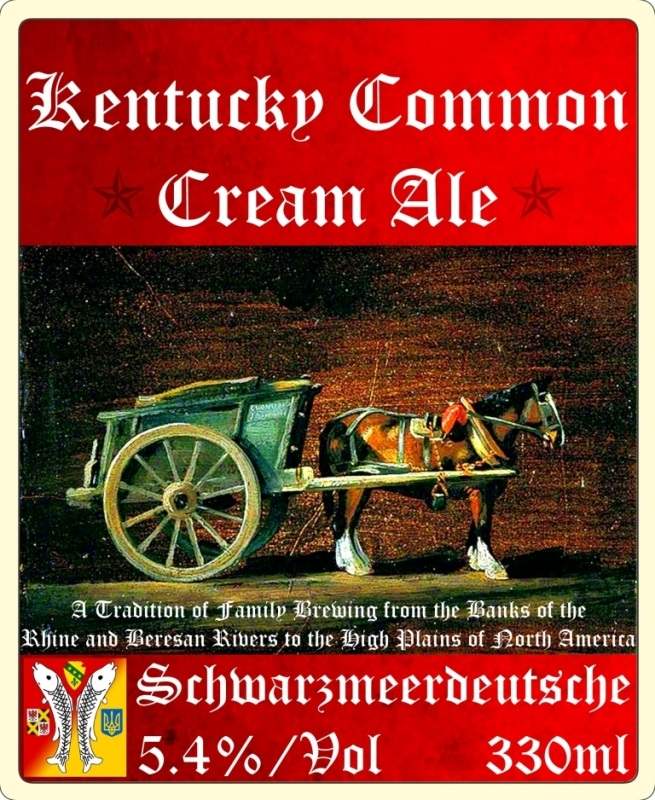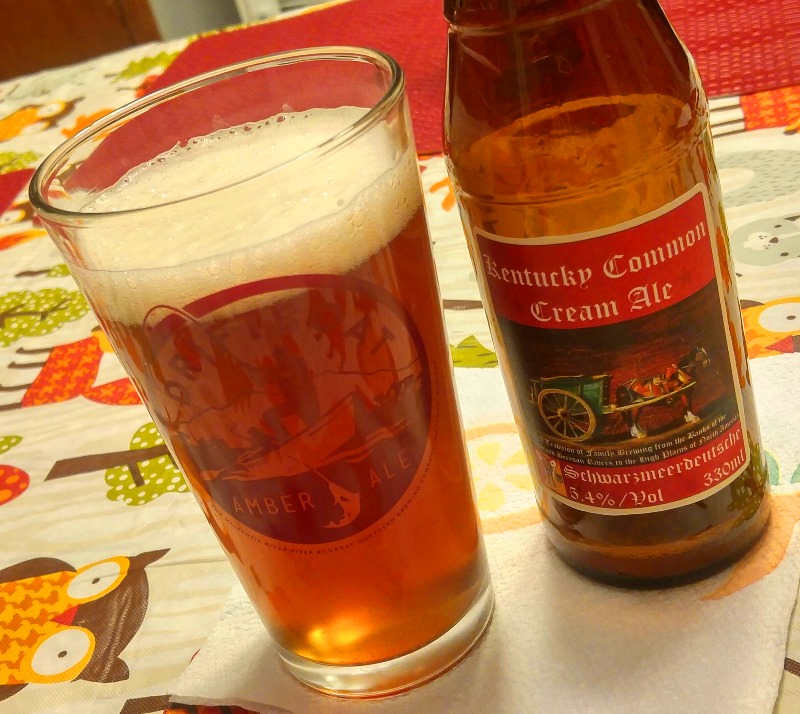TasunkaWitko
Well-Known Member
Note - This recipe is "in development," so there will be a lot of brain-storming, back-and-forth discussion and mind-changing. Because of that, this post will be modified from time to time, until the final version is settled upon.
Any and all input is welcome, as I am flying a little bit blind, here.
A truly home-grown variety, this beer was intensely popular in Kentucky from the post-Civil-War period until Prohibition. Based on that little there is available (sources below), and extrapolating from the known to the vague, I've developed what I think is a reasonably-plausible adaptation.
This 1-gallon adaptation bypasses the corn-grit cereal mash with flaked corn and employs a 60-minute boil, rather than 120 minutes. The caramel malt that I chose was due to its middle-of-the-road quality, while the hops and yeast seem to be the best compromise between what was described and what is available. Northern Brewer is probably not exactly the right bittering hop, but it seems to be the closest that I can find to "California Gray." I chose Hallertau rather than Saaz as an aroma hop because I believe that the Germans who were doing the brewing would have used this Bavarian variety.
Based on the statistics, this adaptation seems to fit the BJCP guidelines fairly well; not perfectly, by any means, but to the point where the average home-brewer in 2016 can give it a go.
Kentucky Common Ale
TasunkaWitko's Adaptation
1 Gallon, All-Grain
ABV - 5.07%
IBUs - 25.30
SRM 11.42
OG - 1.050
FG - 1.012
Grain percentages:
60% 6-Row Pale Malt
37% Corn Grits
1.75% Black Malt
1.25% Caramel Malt
Based on 10-gallon adaptation, 1 gallon contains 1.825 pounds total grains = 29.2 ounces
Available information converted to 1 gallon:
17.52 ounces = 1.095 pounds 6-Row Pale Malt
10.8 ounces = 0.675 pounds Flaked Corn
0.5 ounces = 0.031 pounds Black Malt
0.4 ounces = 0.025 pounds Caramel/Crystal 60L Malt
Mash - 156 to 158 degrees
60-minute boil
Hops:
Cluster - 1.4 grams = 0.05 ounces @ 60 minutes
Cluster - 2.8 grams = 0.1 ounces @ 45 minutes
Cluster - 2.1 grams = 0.075 ounces @ 15 minutes
Hallertau - 1.4 grams = 0.05 ounces @ Flameout
Irish Moss - 2.5 grams = 0.09 ounces = 1/2 teaspoon @ 15 minutes
Yeast - Safale US-05 - 1/2 package = 5.5g
Sources:
http://www.bjcp.org/docs/NHC2014-kycommon-handout.pdf
http://bjcp.org/docs/2015_Guidelines_Beer.pdf - pg 55
http://brooklynbrewshop.com/themash/hop-of-the-month-ahtanum/
http://brooklynbrewshop.com/themash/hop-of-the-month-cluster-hop/
http://brooklynbrewshop.com/themash/hop-of-the-month-saaz/
Any and all input is welcome, as I am flying a little bit blind, here.
A truly home-grown variety, this beer was intensely popular in Kentucky from the post-Civil-War period until Prohibition. Based on that little there is available (sources below), and extrapolating from the known to the vague, I've developed what I think is a reasonably-plausible adaptation.
This 1-gallon adaptation bypasses the corn-grit cereal mash with flaked corn and employs a 60-minute boil, rather than 120 minutes. The caramel malt that I chose was due to its middle-of-the-road quality, while the hops and yeast seem to be the best compromise between what was described and what is available. Northern Brewer is probably not exactly the right bittering hop, but it seems to be the closest that I can find to "California Gray." I chose Hallertau rather than Saaz as an aroma hop because I believe that the Germans who were doing the brewing would have used this Bavarian variety.
Based on the statistics, this adaptation seems to fit the BJCP guidelines fairly well; not perfectly, by any means, but to the point where the average home-brewer in 2016 can give it a go.
Kentucky Common Ale
TasunkaWitko's Adaptation
1 Gallon, All-Grain
ABV - 5.07%
IBUs - 25.30
SRM 11.42
OG - 1.050
FG - 1.012
Grain percentages:
60% 6-Row Pale Malt
37% Corn Grits
1.75% Black Malt
1.25% Caramel Malt
Based on 10-gallon adaptation, 1 gallon contains 1.825 pounds total grains = 29.2 ounces
Available information converted to 1 gallon:
17.52 ounces = 1.095 pounds 6-Row Pale Malt
10.8 ounces = 0.675 pounds Flaked Corn
0.5 ounces = 0.031 pounds Black Malt
0.4 ounces = 0.025 pounds Caramel/Crystal 60L Malt
Mash - 156 to 158 degrees
60-minute boil
Hops:
Cluster - 1.4 grams = 0.05 ounces @ 60 minutes
Cluster - 2.8 grams = 0.1 ounces @ 45 minutes
Cluster - 2.1 grams = 0.075 ounces @ 15 minutes
Hallertau - 1.4 grams = 0.05 ounces @ Flameout
Irish Moss - 2.5 grams = 0.09 ounces = 1/2 teaspoon @ 15 minutes
Yeast - Safale US-05 - 1/2 package = 5.5g
Sources:
http://www.bjcp.org/docs/NHC2014-kycommon-handout.pdf
http://bjcp.org/docs/2015_Guidelines_Beer.pdf - pg 55
http://brooklynbrewshop.com/themash/hop-of-the-month-ahtanum/
http://brooklynbrewshop.com/themash/hop-of-the-month-cluster-hop/
http://brooklynbrewshop.com/themash/hop-of-the-month-saaz/









